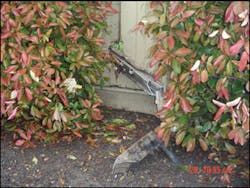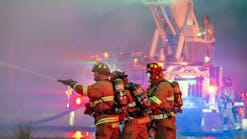Subject: Pressurized Vessels on Vehicles: Part 4 - Energy-Absorbing Bumper Systems
Topic: Catastrophic failure of energy-absorbing bumper systems during vehicle fires
Objective: Review real-world incidents of energy-absorbing bumper systems strut failures when exposed to high heat levels during vehicle fires
Task: Establish procedural guidelines for operating at vehicle fires, including engine compartment fires, to ensure maximum safety for suppression personnel from the hazard of energy-absorbing bumper system strut failures
Our series on pressurized vessels began by looking at the hazards of pressurized struts at extrication scenes. We continued with a look at how vehicle fires cause items such as the pressurized hood struts that have replaced conventional hinges to fail violently. In Part 3, stored-gas inflators for airbag systems were shown to also be a hazard under fire conditions. There is a possibility that the pressurized vessel will blow its top. In this column, we look at the hazard of pressurized vessels that first appeared on automobiles back in 1973: the energy-absorbing bumper system.
All passenger vehicles are required to have front and rear bumper systems that absorb impacts up to 2.5 miles per hour without damage to the vehicle. One design of an energy-absorbing bumper system utilizes fluid-filled pressurized struts. The two-piece energy absorbers telescope inward to absorb the impact energy. These cylinder-shaped struts have no relief devices and have long been known to be an explosion hazard during vehicle fire scenarios.
Incidents involving bumper strut explosions at vehicle fires have haunted fire responders since their introduction on automobiles. Bumper explosion incidents continue to be reported from all across the United States. One recent incident that was a close call for Salinas, CA, Rural Fire Protection District responders, occurred on March 29, 2005.
Responders arrived to find a fully involved engine compartment fire in a Volvo station wagon parked at the curb in a residential neighborhood. The engine spotted approximately 80 feet upwind, facing the burning vehicle. Firefighters approached the vehicle at a 45-degree angle to the driver's front corner with a charged handline. Just before water was applied to the fire, a loud explosion was heard. Personnel on the handline assumed this was a tire that had failed and continued with extinguishment.
After the fire was knocked down and the smoke cleared, it became apparent that the entire front bumper of the Volvo was missing. It was found approximately 20 feet from the vehicle, where it had speared itself into a nearby wooden fence. The bumper and one of the energy-absorbing struts, weighing a total of approximately 50 pounds, had exploded off the burning Volvo and traveled at a speed fast enough not to be seen by any of the three personnel standing less than 10 feet away.
Our conventional training for vehicle fire attack is to approach the vehicle from a front or rear corner, uphill and upwind. As our series on pressurized vessels has pointed out, because of the potential for explosion of an overheated bumper strut, an airbag stored-gas inflator or the pressurized hood struts on modern day vehicles, it may be a safer procedure for attack personnel to approach the vehicle directly from the side at a point between the front and rear tires. This minimizes the chance that the crew will be in the path of an exploding strut, inflator, or hood hinge.
Flow a water stream under the burning vehicle in a sweeping pattern while still at a safe distance. Knock down the apparent fire in the engine compartment, occupant area or the rear portion of the vehicle prior to placing any personnel in front of or behind the vehicle. The author refers to the initial nozzle sweeping action that cools the undercarriage and many of the pressurized vessels as "getting the upper hand on the lower foot." If you can get a cooling spray of water along the lower 12 inches of a burning vehicle, you'll go a long way toward cooling many of the pressurized vessels that are being heated towards their failure point.
Remember, with a burning vehicle, if you see open flame, the vehicle is totaled. Do the job right. Attack as if your life depends on it... because it does!
TASK: Establish procedural guidelines for operating at vehicle fires, including engine compartment fires, to ensure maximum safety for suppression personnel from the hazard of energy absorbing bumper system strut failures.
Ron Moore, a Firehouse contributing editor, is a battalion chief and the training officer for the McKinney, TX, Fire Department. He also authors a monthly online article in the Firehouse.com "MembersZone" and serves as the Forum Moderator for the extrication section of the Firehouse.com website. Moore can be contacted directly at [email protected].






